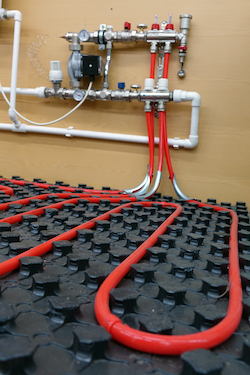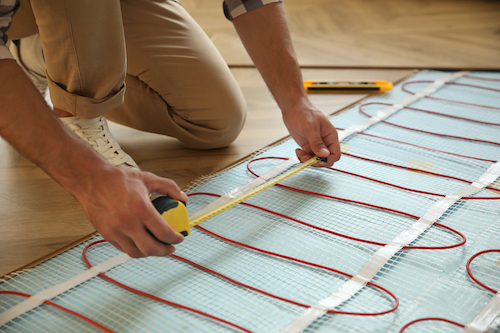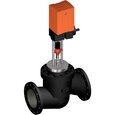Radiant Floor Heating

Figure 1: Hydronic radiant floor heater
Radiant floor heating is a heating system that warms the floor of a room or building from below. It works by circulating hot water through pipes or electric heating cables installed under the floor. The heat is then radiated upwards, warming the objects and surfaces in the room. Read our heat exchanger overview article for more details on the various types of heat exchangers, their typical applications, and their pros and cons.
Table of contents
- Advantages of radiant floor heating
- Radiant heating types
- Radiant floor heating installation
- Disadvantages
- FAQs
View our online selection of HVAC valves!
Radiant heating types
There are two main types of radiant floor heating: hydronic and electric.
Hydronic radiant floor heating
Hydronic floor heating uses tubes of heated water that run in curving lines below the floor. This radiator system involves heating the water from a boiler system and circulating it through loops of polyethylene tubing. The boiler system for hydronic radiant floor heating can heat multiple rooms and surfaces and hence is favorable while constructing new buildings. Also, some houses already have a boiler for other heating needs so that the radiant heating system can be tapped into the boiler. However, hydronic heating requires routine maintenance on the boiler, like any system with a connected utility unit. The system is also complicated to install compared to an electric radiant floor heater. Hydronic radiant floor heating systems cost more to install, but they can be more energy-efficient once the system starts operating.
Electric radiant floor heating
Electric radiant floor heating systems use electric cables or mats installed under the floor (Figure 3). The cables are composed of nickel and chromium alloy, then encased in a moisture-resistant polymer. These cables or mats are connected to a thermostat and a power source and heat up when electricity flows through them. The heat is then transferred to the floor and radiated upwards, warming the room. A simple switch or smart home signal can activate the heating mechanism. Electric radiant floor heating is easier to install as a renovation project for existing homes and can be placed under any type of floor. However, the system can be expensive to heat a whole house; therefore, it is best suited for spot heating, like taking the chill off a stone countertop or tiled bathroom.
Advantages of radiant floor heating
Radiant floor heating has several advantages over traditional forced-air heating systems.
- Radiant floor heating provides a more even heat distribution throughout the space. With conventional systems, the heat tends to rise to the ceiling, leaving some areas feeling cold. Radiant floor heating, on the other hand, warms the entire floor evenly, which can create a more comfortable environment.
- Radiant floor heating is more energy efficient. As it heats the space from the ground up, it does not require as much energy to maintain a comfortable temperature. This can lead to lower energy bills and a more environmentally friendly heating system.
- Radiant floor heating can heat a single room (like a bathroom) as per needs.
- In addition to being more efficient and comfortable, radiant floor heating can be installed under various flooring materials, including tile, wood, and carpet. It does not require any ductwork or vents. It is relatively low maintenance, with only occasional checks and flushes of the system required. Also, the system remains invisible from the surface and doesn’t hinder the room's aesthetics.
Radiant floor heating installation
For insulated interior floors, radiant floor heating systems are installed between the foundation or subfloor and the upper floor, with the heating system as the floating membrane. The individual layers of radiant heat flooring are:
- Subfloor
- Insulation board
- Membrane
- Heat-line
- Insulation board
- Floor
There are a few points to consider before installing the radiant heater.
- Choose the radiant floor heater type that suits your needs. Two types of radiant floor heating systems are: hydronic and electric. Hydronic systems use hot water to heat the floors, while electric systems use electricity. Both systems have pros and cons, and the best choice will depend on the specific needs and budget.
- Determine the size and layout of the heating system: The size of the heating system will depend on the room size and the amount of heat needed. It's essential to measure the room’s square footage and consult with a heating specialist to determine the right size and layout for the system.

Figure 2: Different layouts for the placement of tubes/electric wires
- Prepare the floor. Remove any existing flooring, such as carpet or tile, and smooth out any imperfections in the subfloor. It is important to have a smooth, even surface to ensure proper heat distribution. If the floor is made of concrete, grind or polish the surface to create a smooth finish.
The radiant floor heater can be installed once these preparatory works are done.
Hydronic radiant floor heater
- First, install a layer of insulation over the subfloor to help improve the system's efficiency.
- Install the PEX (cross-linked Polyethylene) tubing or panels according to the layout created. This will typically involve laying the tubing in a spiral pattern or installing the panels grid-like. You'll need to ensure the tubing or panels are spaced evenly and securely attached to the subfloor.
- Once the tubing or panels are installed, connect them to the manifold, which will distribute the hot water to the different sections of the system. You'll also need to install the water heater or boiler and connect it to the manifold using the appropriate piping.
- Install the control system. The control system is programmed to regulate the floor's temperature and turn the system on and off as needed. This will typically involve running wiring from the control system to the water heater or boiler, as well as installing a thermostat or programmable controller in a convenient location.
Electric radiant floor heater
- Lay the heating element: Once the floor is prepared, you can begin laying the heating element. This typically involves unrolling the element and securing it to the floor using staples, tape, or another adhesive. It's important to follow the manufacturer's instructions carefully to ensure a proper installation.
- Install the thermostat: The thermostat allows the user to control the floor's temperature and adjust it to the desired level of warmth. Install the thermostat according to the manufacturer's instructions, and ensure to locate where it can accurately measure the room's temperature.
- Install the flooring: Once the heating cables or mats are in place, you can install the new flooring material, such as tile, hardwood, or laminate.
- Test the system: Once the installation is complete, it is important to test the system to ensure it works correctly. This may involve turning on the system and adjusting the thermostat to ensure that the floor is heating up as expected.

Figure 3: Installing electric radiant heater
Where to install radiant floor heating
The best place to install radiant floor heating is any room with a cold floor, like bathrooms, kitchens, hardwired living rooms, or solarium gardens.
Disadvantages
- Cost: Radiant floor heating systems can be expensive to install (for example, hydronic heaters), especially while retrofitting an existing home.
- Complexity: Hydronic radiant systems require specialized knowledge and skills to install, which can be challenging.
- Lack of control: It can be difficult to regulate the temperature of individual rooms or areas with a radiant floor heating system, as the heat is distributed evenly throughout the space.
- Time-consuming: Radiant floor heating takes longer to heat up and cool down.
- Limited options for repair or replacement: If any part of the system fails or needs to be replaced, finding the necessary replacement parts or a qualified technician to perform the repair can be challenging.
- Limited design options: Radiant floor heating systems typically require a specific type of flooring material and may limit your design options for your space.
Read our articles on solar, portable, and electric infrared heaters for more details on various heater types.
FAQs
What is radiant floor heating?
Radiant floor heating is a type of heating system that warms the floor of a room or building from below. It works by circulating hot water or electricity through pipes or electrical cables installed on the floor.
How long does radiant floor heating take to install?
It typically takes about two to three days to complete the installation of radiant floor heating and the new floor.
Is radiant floor heating enough to heat a house?
Yes, radiant floor heating is an effective and viable way to heat a house.
How long do radiant floor heaters last?
Once installed, radiant floor heaters can last for around twenty years.











